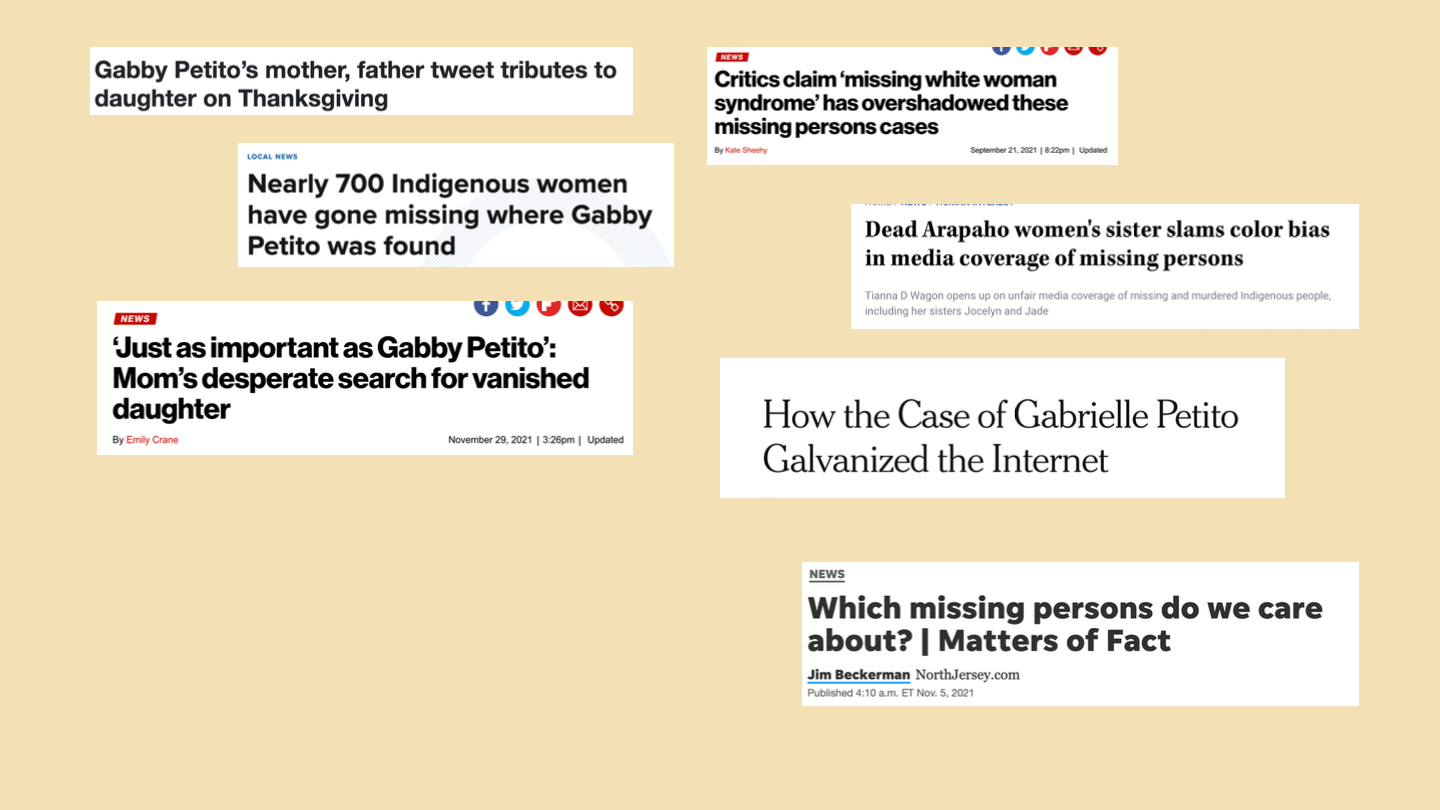Jocelyn Watt, Jade Wagon and Gabby Petito: Disparity in Coverage
Indigenous sisters’ cases remain unsolved and invisible as Gabby Petito’s case continues to make headway in mainstream media.

A media frenzy that covered the search for her body and the search for her fiancé took the nation by storm this year. In June 2021, 22-year-old Gabby Petito set out on a cross-country journey with her finacé, Brian Laundrie. They shared their travels with thousands of fans on social media.
Three months ago, on September 11, 2021, Petitio’s family in New York reported her as a missing person. The following media frenzy that covered the search for her body and the search for her fiancé took the nation by storm.
Gabby Petito was a cis-gendered white woman who had become the victim of tragedy. Her very public story is foreign to the thousands of missing Indigenous women, whose forgotten stories remain hidden. Unlike Petitio, they don’t have the luxury of being discussed on major news networks like CNN, NBC, and CBS. Unlike Petito, many of their cases remain a mystery– swept under the rugs of countless local police stations.
The search for Petito gained thousands of likes, comments, and shares on social media platforms like TikTok and Instagram. The search for any signs of Petito in Teton county was extensive and exhaustive. On October 19, just over a month after her reported disappearance, searchers located human remains later identified as having belonged to Petito, according to Maxouris.
On January 28, 1988, Nicole Wagon (then Watt) and Darryl Davis gave birth to Jocelyn Watts in West Germany, according to her obituary. Eight years later, after the family’s move back to the States, Nicole and Tracy Wagon gave birth to Jade Wagon on February 3, 1996, in Riverton, Wyoming
Watts and Wagon grew up on the Northern Arapaho Tribe’s Reservation for the majority of their childhoods. They learned from their mother to embrace their intersecting Catholic beliefs and Indigenous practices, according to the podcast “Bite-Sized Crime.” Life kept the sisters tied to Riverton for the remainder of their adult lives.
After graduating from the Southwestern Indian Polytechnic Institute in New Mexico, Watt worked at the Wind River Casino and (later) the Riverton Vision Center. She and her partner, Rudy Perez, lived together in a house in the 1100 Block of East Main Street.
On January 5, 2019, someone found the pair dead in their home, having died from gunshot wounds. “Jocelyn and Rudy were taken from us by the hands of someone- or someone’s- way too soon,” her mother said in an interview to the Rocket Miner. It has been nearly three years since investigators began looking into her case, yet progress in the case continues to be elusive, according to McFarland.
Wagon, unlike her sister, stayed in Riverton after high school. She spent her time raising two children and working at the Wind River Casino. After her sister’s death in January of 2019, Wagon became an active member in the Missing and Murdered Indigenous Women (MMIW) epidemic.
On January 2, 2020, Wagon’s mother reported her as missing. A weeks-long search ended with the recovery of her body. The FBI later ruled her death an accident, citing hypothermia and drug intoxication as the main causes. This final determination remains contested by Wagon’s mother, who believes that her daughter’s death was a homicide.
Both of these sisters’ cases remain unsolved. Even as the years continue to pass, their cases remain on the backburner as cases like that of Gabby Petitio capture the eyes of the masses. The question here is: why?
In 2019, Governor Mark Gordon of Wyoming created the Missing and Murdered Indigenous People Task Force. Through their work, they released a comprehensive report on statistics about the Indigenous population of Wyoming in 2021. These reports are important in understanding how deeply these communities feel the effects of these disappearances and murders.
In their report, the task force found that a population that makes up only 3% of Wyoming’s total accounts for 21% of the homicides that the state sees annually. In that same report, it is purported that 30% of these cases receive media coverage– that number is over 50% for the cases of white people.
Even in the Indigenous cases that the media reported on, they found that their headlines, “were more likely to contain violent language, portray the victim in a negative light, and provide less information as compared to articles about White homicide victims.” They also learned about the creation of 1,254 missing person records for Indigenous people in 22 of 23 counties in Wyoming. It is in these disparities that movements, like the MMIW in which Wagon was an active member, take issue.
“Our women, girls, and two-spirits are being taken from us in an alarming way … [the] majority of these murders are committed by non-Native people on Native-owned land,” writes MMIW on their website. The intersectional identities of these cases are important in understanding why they remain unsolved to this day.
Watt and Jocelyn both lived as brown-skinned Indigenous peoples. They both identified as women. They both spent most of their lives in the North Arapaho Tribe’s reservation, which sees substantially higher rates of poverty compared to the rest of the States.
In the Northern Arapaho Tribe specifically, the Wyoming task force’s report states that there are glaring disparities for Native communities like hunger and food, housing and heat, poverty, health, and alcoholic beverage use. It is these disparities, which are largely the fault of federal and state governments, that make Indigenous people (and Indigenous deaths) unimportant to those in power.
Especially in our capitalistic society, a person’s potential value determines their societal worth. In other words, is the amount of money that the government would have to spend in the search for the answers to these girls’ cases equivalent to their potential societal worth? In a country that, built upon the grounds of native genocide, slavery, and liberty for any white man who wants it, rejects “non-normal” people, the simple answer to this question is no.
We can see this in the stereotypes that have continued to emerge around and about Indigenous people. Indigenous people are uncivilized and stuck in the “backward” ways of their ancestors, Indigenous people are freeloaders who live off of help from the government, and Indigenous people are all the same alcoholic types portrayed in popular media, or they are solely there to make dream catchers and serve as spiritual beings.
“… [M]aybe she just ran away. Was she out drinking? Does she do sex work?” Abigail Echo-Hawk said about the questions police ask of missing Indigenous women’s families. This is how these stereotypes manifest.
Rather than question how these women are going missing, investigators look to find ways in which they compromised themselves. It is in this “it’s her fault” mentality that these cases, much like Wagon’s, face ultimate dismissal. Missing white women play the damsels in distress while missing brown women play villains in their own stories.
The grounds for the recovery of Petito’s remains were largely influenced by the engagement with her case from the general public. It was through the coverage of major news networks and the interaction with her story on social media that the investigators felt the pressure to put everything they could into the investigation.
Her story generated millions of dollars in ad revenue for networks big and small. In this, those profiting from the revenue found a perfect circular ecosystem: more coverage of Petito’s case means more money, so we should cover Petito’s case more to make more money. Likely because of their intersecting identities, the stories of Watt and Wagon weren’t profitable enough for the media to cover (in their eyes), so it was better left unreported and forgotten.
In an interview Nicole Wagon gave to Insider, the mother of Wagon and Watt, said “I believe if my daughters even had half the coverage, maybe they would be solved.”
Nicole Wagon lost two of her precious daughters only a year apart from one another. It is through this pain and suffering that Wagon has become passionate about the movement to protect Indigenous women and solve the unsolved cases of her daughter’s deaths. Her efforts are those of a transformational leader as she continues to fight for reform in the way cases, like her daughters’, are investigated.
Their being women made them vulnerable as society labels women as easy, fragile targets for abusers. Their being brown made them perfect targets because past precedent shows that those in power would sooner believe and give value to the word of a white person than a brown person, much less a brown woman.
Their being located in a place where poverty is all too common made them seem less desirable to the people who would have had to put resources into the investigative process. Them possessing all of these identities was the deciding factor in whether or not their cases would remain unsolved, untouched, and utterly forgotten or become a media phenomenon.
As a population, we must recognize how we collectively ignore issues of our own. It is in the dismissal of cases like those of Wagon and Watts that we lose our humanity and our ability to show empathy toward their deaths. We must recognize how societal structures force these women into oppression, and how we singularly perpetuate that oppression.
It is in the stories of missing and murdered Indigenous women that we must acknowledge our mistakes. It is in these stories that we will find the solutions to create a better society.

